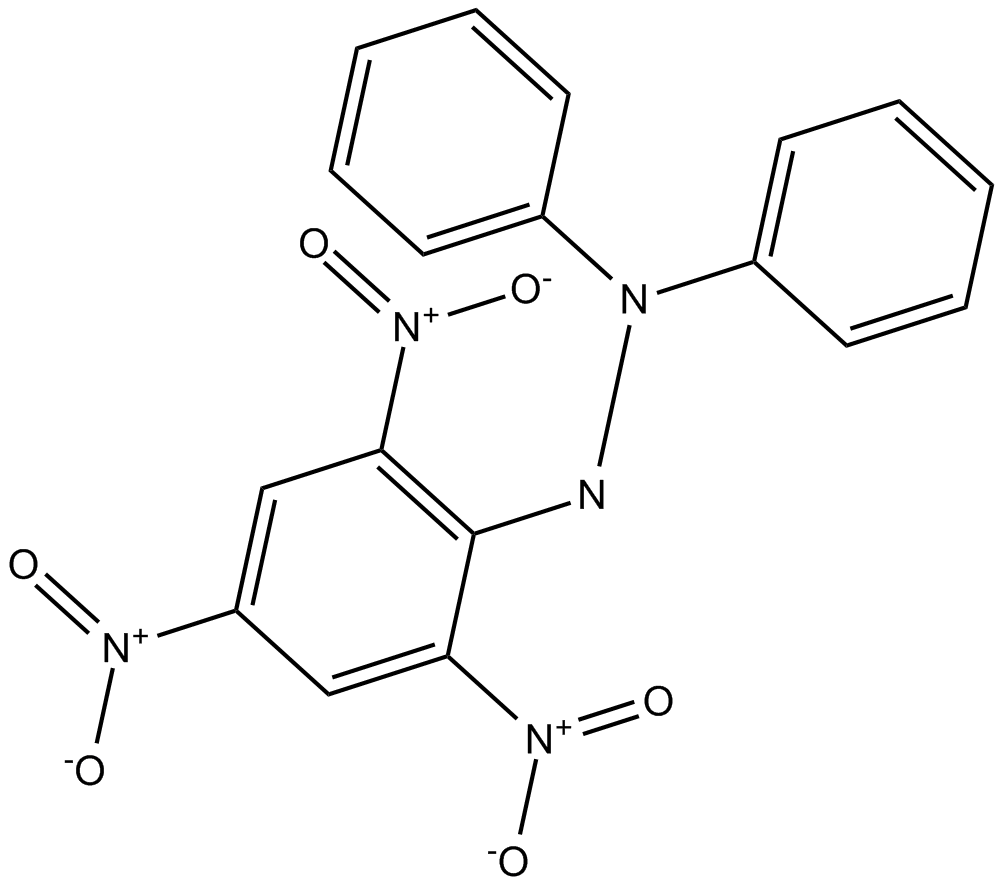DPPH (Synonyms: 2,2-Diphenyl-1-Picrylhydrazyl DPPH radical) |
| Catalog No.GC19475 |
A colorimetric probe for free radical scavengers
Products are for research use only. Not for human use. We do not sell to patients.

Cas No.: 1898-66-4
Sample solution is provided at 25 µL, 10mM.
DPPH (1,1-diphenyl2-picrylhydrazyl) is a stable free radical because of its spare electron delocalization over the whole molecule. The DPPH assay, which is one of the best-known, frequently employed, and accurate methods. The delocalization causes a deep violet color with 竹max around 520 nm. When a solution of DPPH is mixed with a substrate acting as a hydrogen atom donor, a stable nonradical form of DPPH is obtained with simultaneous change of the violet color to pale yellow[1].
DPPH assay has been successfully utilized for investigating antioxidant properties of wheat grain and bran, vegetables, conjugated linoleic acids, herbs, edible seed oils, and flours in several different solvent systems including ethanol, aqueous acetone, methanol, aqueous alcohol and benzene [2,3]. DPPH assay is a convenient method for the antioxidant assay of cysteine, glutathione, ascorbic acid, tocopherol and polyhydroxy aromatic compounds [4], for olive oil, fruits, juices and wines [5].
References:
[1]. Szabo M, Idi?oiu C, Chambre D, et al. Improved DPPH determination for antioxidant activity spectrophotometric assay[J]. Chemical Papers, 2007, 61(3): 214-216.
[2]. Yu L. Free radical scavenging properties of conjugated linoleic acids[J]. Journal of Agricultural and Food Chemistry, 2001, 49(7): 3452-3456.
[3]. Parry J, Su L, Luther M, et al. Fatty acid composition and antioxidant properties of cold-pressed marionberry, boysenberry, red raspberry, and blueberry seed oils[J]. Journal of agricultural and food chemistry, 2005, 53(3): 566-573.
[4]. Nishizawa M, Kohno M, Nishimura M, et al. Non-reductive scavenging of 1, 1-diphenyl-2-picrylhydrazyl (DPPH) by peroxyradical: a useful method for quantitative analysis of peroxyradical[J]. Chemical and Pharmaceutical bulletin, 2005, 53(6): 714-716.
[5]. S芍nchez-Moreno C. Methods used to evaluate the free radical scavenging activity in foods and biological systems[J]. Food science and technology international, 2002, 8(3): 121-137.
Average Rating: 5 (Based on Reviews and 6 reference(s) in Google Scholar.)
GLPBIO products are for RESEARCH USE ONLY. Please make sure your review or question is research based.
Required fields are marked with *





